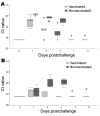Protection and virus shedding of falcons vaccinated against highly pathogenic avian influenza A virus (H5N1)
- PMID: 18217549
- PMCID: PMC3375792
- DOI: 10.3201/eid1311.070705
Protection and virus shedding of falcons vaccinated against highly pathogenic avian influenza A virus (H5N1)
Abstract
Because fatal infections with highly pathogenic avian influenza A (HPAI) virus subtype H5N1 have been reported in birds of prey, we sought to determine detailed information about the birds' susceptibility and protection after vaccination. Ten falcons vaccinated with an inactivated influenza virus (H5N2) vaccine seroconverted. We then challenged 5 vaccinated and 5 nonvaccinated falcons with HPAI (H5N1). All vaccinated birds survived; all unvaccinated birds died within 5 days. For the nonvaccinated birds, histopathologic examination showed tissue degeneration and necrosis, immunohistochemical techniques showed influenza virus antigen in affected tissues, and these birds shed high levels of infectious virus from the oropharynx and cloaca. Vaccinated birds showed no influenza virus antigen in tissues and shed virus at lower titers from the oropharynx only. Vaccination could protect these valuable birds and, through reduced virus shedding, reduce risk for transmission to other avian species and humans.
Figures



References
-
- Swayne DE, Halvorson DA. Influenza. In: Saif YM, Barnes HJ, Glisson JR, Fadly AM, McDougald LR, Swayne DE, editors. Diseases of poultry, 11th ed. Ames (IA): Iowa State Press; 2003; 135–60.
-
- Temple SA. Do predators always capture substandard individuals disproportionately from prey populations? Ecology. 1987;68:669–74. 10.2307/1938472 - DOI
Publication types
MeSH terms
Substances
LinkOut - more resources
Full Text Sources
Medical
